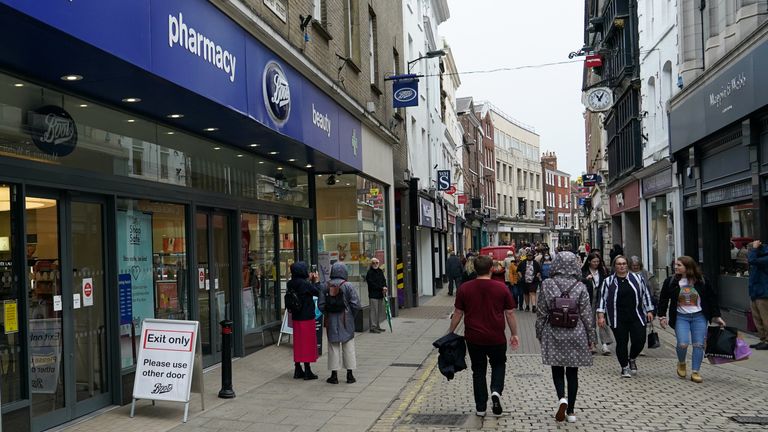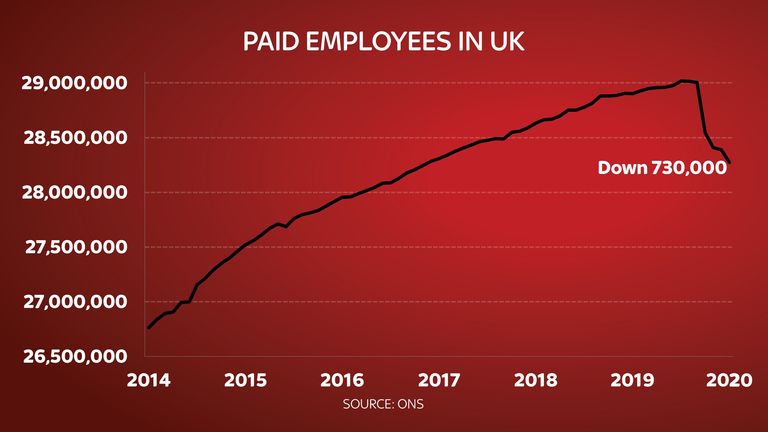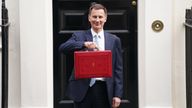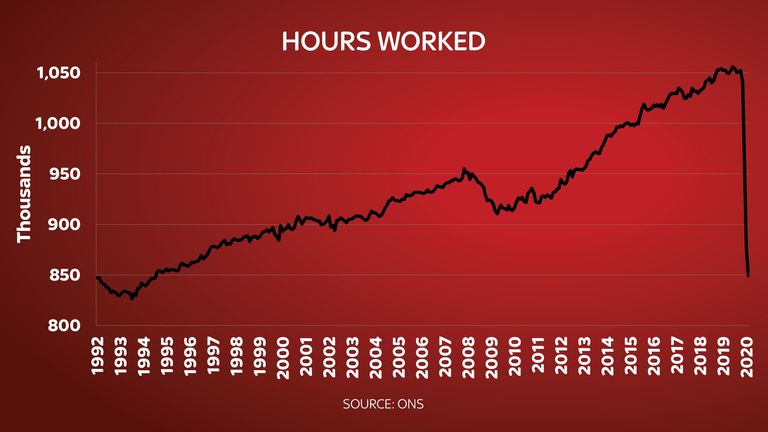Coronavirus: 730,000 jobs lost since lockdown began
The latest official figures paint an increasingly bleak picture for employment and wages despite continuing government support.
Tuesday 11 August 2020 14:56, UK
Company payrolls have plunged by 730,000 since the start of the coronavirus crisis lockdown as the UK braces for a feared acceleration in unemployment.
Data released by the Office for National Statistics (ONS) showed 81,000 net fewer people on payrolls last month alone, despite continuing support for employers via government loans and the Job Retention Scheme for furloughed workers.
The figure does not include self-employed workers - also eligible for taxpayer aid.
The ONS said the claimant count - which covers those claiming benefits for unemployment and because they are on low incomes - rose 116.8% to 2.7 million between March and July.
There was evidence too of a wider squeeze on incomes, with regular pay falling by 0.2% in the three months to June compared to the same period last year.
That represented, the ONS said, the first negative growth in regular nominal earnings since records began in 2001.
In the same period, there were 220,000 fewer people classed as in employment - driven mainly by workers aged 65 and over and the self-employed.
That was the worst quarterly performance since the financial crisis recession of 2009.
The official jobless rate remained static at 3.9% which the number-crunchers said could be explained by the fact that many workers could not be classed as unemployed because they were not actively looking for a job.
The figures were released hours before the Treasury confirmed businesses had secured government-backed loans of almost £52bn to date with 9.6 million workers' pay supported through the Job Retention Scheme.
The figures do not show how many people are currently still receiving support through separate survey findings by the ONS released a fortnight ago suggested that roughly a third of that number had returned to their jobs amid the gradual re-opening of the economy from its COVID-19 hibernation.
But there are predictions of an acceleration in job losses ahead as the wage support is tapered before being withdrawn completely in October.
Last week, the Bank of England warned the jobless rate could hit 7.5% by the year's end.
The travel sector and retail have been among the major employers cutting back on staff already, though research by technology recruiter Harvey Nash suggests sectors hit less hard, including pharmaceuticals, logistics and healthcare, are continuing to create jobs.
Commenting on its findings, ONS deputy national statistician for economic statistics Jonathan Athow said: "The labour market continues recent trends, with a fall in employment and significantly reduced hours of work as many people are furloughed.
"Figures from our main survey show there has been a rise in people without a job and not looking for one, though wanting to work. In addition, there are still a large number of people who say they are working no hours and getting zero pay.
"The falls in employment are greatest among the youngest and oldest workers, along with those in lower-skilled jobs.
"Vacancies numbers began to recover in July, especially in small businesses and sectors such as hospitality, but demand for workers remains depressed."
Analysis: The statistics are yet to catch up with reality
By Ed Conway, economics editor
When it comes to the UK labour market we are still in something of a twilight period.
Hundreds of thousands of people have lost their jobs, redundancies are mounting at an awful rate, yet the official unemployment rate remains (literally) incredibly low, at 3.9%.
Total employment is down by 220,000 in the three months to June - better than expected. And while the official measure of redundancies is up to 134,000 - the highest since 2013 - it is still well below where it hit after the financial crisis.
While it is tempting to take some reassurance from these statistics, the depressing likelihood is that they simply have yet to catch up with reality.
We are currently in that moment from the Road Runner cartoons when Wile E. Coyote has run off the cliff and is about to realise he is no longer standing on terra firma - but for the time being gravity has yet to impose itself.
Why are we still in this twilight zone? In part it's because even in a "normal" recession it takes time for job losses to show up in the official statistics, which tend to be quite "laggy".
In part it's because of the measures implemented by the Treasury in the past few months.
The furlough scheme is designed to keep people in employment, even if they're not working. But as the furlough scheme comes to its end (the cost is being ratcheted up for employers as of this month) many of those people who are on it will sadly find that they do not have jobs to come back to.
We are only going through that process now. Indeed this month, August, may ultimately prove to be the worst in terms of the increase in job losses, but it will take some time for that to appear in the official statistics.
Even so, there is already clear evidence from other unofficial unemployment measures produced by the ONS since the onset of the pandemic that things are not looking good.
In particular, the number of paid employees is down very sharply indeed, 730,000 below the pre-crisis peak. Universal credit claims are up by an unprecedented 117% since March, hitting 2.7 million in July 2020, and while some of those claimants remain in work, this is typically an early warning signal for an impending rise in unemployment.
The ONS estimates that 7.5 million people - more than a quarter of the workforce - were temporarily away from work in recent months. The real question now is how many of those temporary absences become permanent, as the furlough scheme comes to an end and the UK economy adjusts to the "new normal", whatever that is.













